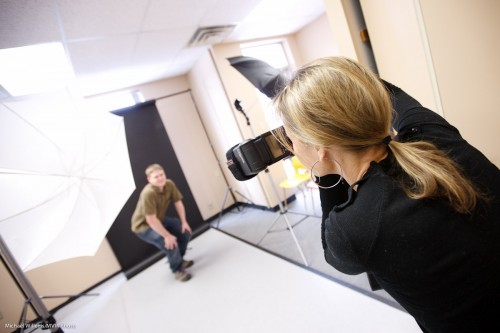One setup at yesterday’s music school shoot was this one:
We did four setups:
- One traditional “three strobes” setup.
- One setup with one strobe and a reflector, in a small piano room.
- One drum room with just an on-camera bounced flash.
- The above “overflow” three speedlight setup: main light through an umbrella, fill into an umbrella, and a background light.
The first three setups are pretty straightforward. For the last, the question was: TTL or manual?
Yes, you can use the flashes on manual and still use wireless “commander mode” to drive them.
But when you are only going to use a setup for a few shots, it is often just as easy to leave the flashes in TTL mode. Works fine.
But there is one very important thing to keep in mind. TTL measures reflected light. And with a black background, keep in mind that the more background you get onto the image, or the darker your subject is, the higher the exposure will be (the camera’s metering system is dumb: it does not know what your subject is: it sees a darker picture). And vice versa. So you need to compensate for this with flash compensation. When using TTL, be ready to use flash compensation for many shots. If I had set the flashes to manual, and metered, each shot would then have been perfect, independent of the subject or composition.
So why did I use TTL instead of metering? Ease of use. Only a few shots at this setup, so why make it difficult? Sometimes the easy way out is the best way out.

